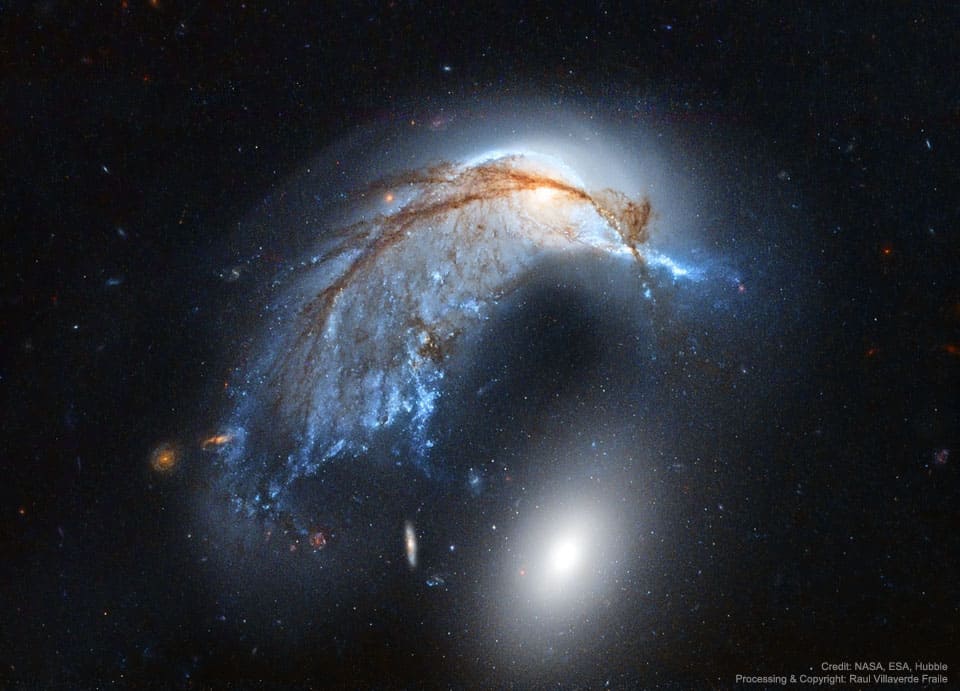Blog
Just a few hundred million years ago, NGC 2936, the upper of the two large galaxies shown, was likely a normal spiral galaxy — spinning, creating stars — and minding its own business. But then it got too close to the massive elliptical galaxy NGC 2937 below and took a dive. Dubbed the Porpoise Galaxy for its iconic shape, NGC 2936 is not only being deflected but also being distorted by the close gravitational interaction. A burst of young blue stars forms the nose of the porpoise toward the right of the upper galaxy, while the center of the spiral appears as an eye. Alternatively, the galaxy pair, together known as Arp 142, look to some like a penguin protecting an egg. Either way, intricate dark dust lanes and bright blue star streams trail the troubled galaxy to the lower right. The featured re-processed image showing Arp 142 in unprecedented detail was taken by the Hubble Space Telescope last year. Arp 142 lies about 300 million light years away toward the constellation, coincidently, of the Water Snake (Hydra). In a billion years or so the two galaxies will likely merge into one larger galaxy.

Lowell “Sly” Fillmore Dunbar (born 10 May 1952, Kingston, Jamaica) is a drummer, best known as one half of the prolific Jamaican rhythm sectionand reggae production duo Sly and Robbie.
Dunbar began playing at 15 in a band called The Yardbrooms. His first appearance on a recording was on the Dave and Ansell Collins album Double Barrel. Dunbar joined a band Ansell Collins called Skin, Flesh and Bones.
Speaking on his influences, Sly explains “My mentor was the drummer for The Skatalites, Lloyd Knibb. And I used to listen a lot to the drummer for Booker T. & the M.G.’s, Al Jackson Jr., and a lot of Philadelphia. And there are other drummers in Jamaica, like Santa and Carly from The Wailers Band, Winston Bennett, Paul Douglas, Mikey Boo. I respect all these drummers and have learnt a lot from them. From them, I listened and created my own style. They played some things I copied, other things I recreated.”
In 1972, Dunbar met and became friends with Robbie Shakespeare, who was then bass guitarist for the Hippy Boys. Shakespeare recommended Dunbar to Bunny Lee as a possible session drummer for the Aggrovators. Dunbar and Shakespeare decided to continue performing together. They worked with Peter Tosh and his band until 1981, recording five albums.
Dunbar noted about the Mighty Diamonds‘ song “Right Time”: “When that tune first come out, because of that double tap on the rim nobody believe it was me on the drums, they thought it was some sort of sound effect we was using. Then when it go to number 1 and stay there, everybody started trying for that style and it soon become established.” According to The Independent, the entire album Right Time was “revolutionary”, the breakthrough album of “masters of groove and propulsion” Dunbar and Shakespeare, with “Sly’s radical drumming matching the singers’ insurrectionary lyrics blow-for-blow.”
Dunbar and Shakespeare formed their Taxi Records label in 1980. It has seen releases from many international successful artists, including Black Uhuru, Chaka Demus and Pliers, Ini Kamoze, Beenie Man and Red Dragon
more...Donovan (born Donovan Philips Leitch, 10 May 1946) is a Scottish singer, songwriter and guitarist. He developed an eclectic and distinctive style that blended folk, jazz, pop, psychedelia, and world music (notably calypso). He has lived in Scotland, Hertfordshire (England), London, California, and since at least 2008 in County Cork, Ireland, with his family. Emerging from the British folk scene, Donovan reached fame in the United Kingdom in early 1965 with live performances on the pop TV series Ready Steady Go!
Having signed with Pye Records in 1965, he recorded singles and two albums in the folk vein for Hickory Records (US company), after which he signed to CBS/Epic Records in the US – the first signing by the company’s new vice-president Clive Davis – and became more successful internationally. He began a long and successful collaboration with leading British independent record producer Mickie Most, scoring multiple hit singles and albums in the UK, US, and other countries.
His most successful singles were the early UK hits “Catch the Wind“, “Colours” and “Universal Soldier” in 1965, written by Buffy Sainte-Marie. In September 1966 “Sunshine Superman” topped America’s Billboard Hot 100 chart for one week and went to number two in Britain, followed by “Mellow Yellow” at US No. 2 in December 1966, then 1968’s “Hurdy Gurdy Man” in the Top 5 in both countries, then “Atlantis“, which reached US No. 7 in May 1969.
He became a friend of pop musicians including Joan Baez, Brian Jones and the Beatles. He taught John Lennon a finger-picking guitar style in 1968 that Lennon employed in “Dear Prudence“, “Julia“, “Happiness Is a Warm Gun” and other songs. Donovan’s commercial fortunes waned after parting with Most in 1969, and he left the industry for a time.
Donovan continued to perform and record sporadically in the 1970s and 1980s. His musical style and hippie image were scorned by critics, especially after punk rock. His performing and recording became sporadic until a revival in the 1990s with the emergence of Britain’s rave scene. He recorded the 1996 album Sutras with producer Rick Rubin and in 2004 made a new album, Beat Cafe. Donovan was inducted into the Rock and Roll Hall of Fame in 2012 and the Songwriters Hall of Fame in 2014.
more...David Thomas Mason (born 10 May 1946) is an English singer-songwriter and guitarist from Worcester, who first found fame with the rock band Traffic. Over the course of his career, Mason has played and recorded with many notable pop and rock musicians, including Paul McCartney, George Harrison, the Rolling Stones, Jimi Hendrix, Eric Clapton, Michael Jackson, David Crosby, Graham Nash, Steve Winwood, Fleetwood Mac, Delaney & Bonnie, Leon Russell and Cass Elliot. One of Mason’s best known songs is “Feelin’ Alright“, recorded by Traffic in 1968 and later by many other performers, including Joe Cocker, whose version of the song was a hit in 1969. For Traffic, he also wrote “Hole in My Shoe“, a psychedelic pop song that became a hit in its own right. “We Just Disagree“, Mason’s 1977 solo US hit, written by Jim Krueger, has become a staple of US classic hitsand adult contemporary radio playlists.
In 2004, Mason was inducted into the Rock and Roll Hall of Fame as a founding member of Traffic. Within the same year, Mason started a new electric guitar company with business partner and Industrial Designer Ravi Sawhney. RKS Guitars was showcased at the 2004 NAMM show in Anaheim, CA.
more...Jimmy Ponder (May 10, 1946 – September 16, 2013) was an American jazz guitarist.
When Ponder’s brother entered the military, he left his guitar, and Ponder picked it up. In his early teens he received lessons from the guitarist in a band for which he sang doo-wop. He was drawn to the jazz guitar he heard on the radio. While playing in a rhythm and blues band, he occasionally inserted a jazz solo. He considers hearing guitarist Thornel Schwartz an important part of his life, when Schwartz was playing with organist Jimmy McGriff. He was impressed by Pat Martino when he saw Martino in the Jack McDuff band. He also cites as influences George Benson, Kenny Burrell, and Rene Thomas, though none surpassed the impact of seeing Wes Montgomery.
He learned the guitar solo from “Daily Double” (Choice), the only 45 rpm single released by Charles Earland. When Earland performed in Pittsburgh, he invited Ponder to sit-in with the band and liked what he heard. Earland promised Ponder he could become a member of the band after he finished high school. Six months after graduating, he was hired by Earland.
He began playing with Earland at 17 and in the following years with Lou Donaldson, Houston Person, Donald Byrd, Stanley Turrentine, and Jimmy McGriff. He moved to Philadelphia and later New York City in the 1970s and recorded extensively as a leader. Since the late 1980s, he frequently returned to his hometown to perform with his trio of two other Pittsburgh musicians, Gene Ludwigand Roger Humphries. Ponder’s highest charting release was Somebody’s Child, which reached No. 3 on the JazzWeek airplay chart in 2007. Ponder died in Pittsburgh at the age of 67 in September 2013.
https://www.youtube.com/watch?v=YQMScuqN05Q
more...Melvin Sokoloff (May 10, 1929 – February 2, 1990), known professionally as Mel Lewis, was an American jazz drummer, session musician, professor, and author. He received fourteen Grammy Award nominations.
Lewis was born in Buffalo, New York, to Russian-Jewish immigrant parents Samuel and Mildred Sokoloff. He started playing professionally as a teen, eventually joining Stan Kenton in 1954. His musical career brought him to Los Angeles in 1957 and New York City in 1963.
In 1966 in New York, he teamed up with Thad Jones to lead the Thad Jones/Mel Lewis Orchestra. The group started as informal jam sessions with the top studio and jazz musicians of the city, but eventually began performing regularly on Monday nights at the famed venue, the Village Vanguard. In 1979, the band won a Grammy for their album Live in Munich. Like all of the musicians in the band, it was only a sideline. In 1976, he released an album titled Mel Lewis and Friends that featured him leading a smaller sextet that allowed freedom and improvisation.
more...“Mother” Maybelle Carter (born Maybelle Addington; May 10, 1909 – October 23, 1978) was an American country musician and originator of the ”Carter scratch.” She is best known as a member of the Original Carter Family act in the 1920s, 30s, and 40s and also as a member of the Carter Sisters and Mother Maybelle.
Maybelle Carter was born Maybelle Addington on May 10, 1909, in Nickelsville, Virginia. She was the daughter of Margaret Elizabeth (née Kilgore; 1879 – 1960) and Hugh Jackson Addington (1877 – 1929). According to family lore, the Addington family of Virginia is descended from former British prime minister Henry Addington, 1st Viscount Sidmouth.
On March 13, 1926, Maybelle married Ezra Carter. They had three daughters, Helen, June and Anita.
https://www.youtube.com/watch?v=XE80Ed59uCY
more...https://www.youtube.com/watch?v=2QMH_9EzNDo
more...Thank You Mama
more...https://www.youtube.com/watch?v=5yRgiXh2fP4
more...Little Richard, Founding Father of Rock Who Broke Musical Barriers, Dead at 87
Little Richard, a founding father of rock and roll whose fervent shrieks, flamboyant garb, and joyful, gender-bending persona embodied the spirit and sound of that new art form, died Saturday. He was 87. The musician’s son, Danny Jones Penniman, confirmed the pioneer’s death to Rolling Stone, adding that the cause of death was cancer.
Starting with “Tutti Frutti” in 1956, Little Richard cut a series of unstoppable hits – “Long Tall Sally” and “Rip It Up” that same year, “Lucille” in 1957, and “Good Golly Miss Molly” in 1958 – driven by his simple, pumping piano, gospel-influenced vocal exclamations and sexually charged (often gibberish) lyrics. “I heard Little Richard and Jerry Lee Lewis, and that was it,” Elton John told Rolling Stone in 1973. “I didn’t ever want to be anything else. I’m more of a Little Richard stylist than a Jerry Lee Lewis, I think. Jerry Lee is a very intricate piano player and very skillful, but Little Richard is more of a pounder.”
Although he never hit the top 10 again after 1958, Little Richard’s influence was massive. The Beatles recorded several of his songs, including “Long Tall Sally,” and Paul McCartney’s singing on those tracks – and the Beatles’ own “I’m Down” – paid tribute to Little Richard’s shredded-throat style. His songs became part of the rock and roll canon, covered over the decades by everyone from the Everly Brothers, the Kinks, and Creedence Clearwater Revival to Elvis Costello and the Scorpions. “Elvis popularized [rock and roll],” Steven Van Zandt tweeted after the news broke. “Chuck Berry was the storyteller. Richard was the archetype.”
https://www.youtube.com/watch?v=u0Ujb6lJ_mM
more...This VLT image of the Thor’s Helmet Nebula was taken on the occasion of ESO’s 50th Anniversary, 5 October 2012, with the help of Brigitte Bailleul — winner of the Tweet Your Way to the VLT! competition. The observations were broadcast live over the internet from the Paranal Observatory in Chile. This object, also known as NGC 2359, lies in the constellation of Canis Major (The Great Dog). The helmet-shaped nebula is around 15 000 light-years away from Earth and is over 30 light-years across. The helmet is a cosmic bubble, blown as the wind from the bright, massive star near the bubble’s centre sweeps through the surrounding molecular cloud.

Anthony Wilson (born May 9, 1968) is an American jazz guitarist, arranger and composer. He is the son of bandleader Gerald Wilson.
Born in Los Angeles on May 9, 1968, Wilson received his degree in music composition from Bennington College. His first major breakthrough was as lead guitarist of the group, Storm in 1980. He counts Duke Ellington, Gil Evans, Wes Montgomery, Ry Cooder, and T-Bone Walker among his influences. His first album Anthony Wilson was nominated for a Grammy Award and his second album, Goat Hill Junket (1998) also received praise. Albums with his nine-piece band include Adult Themes (MAMA, 1999) and Power of Nine (Groove Note, 2006). Diana Krall and mandolinist Eva Scow appear on the latter.
He has also recorded two trio albums with Hammond organist Joe Bagg and drummer Mark Ferber, Our Gang in 2001 and Savivity in 2005 (both on Groove Note). In 2009 he recorded more organ trio music with Jack of Hearts (again for Groove Note) featuring Larry Goldings on Hammond organ, and alternating drummers Jim Keltner and Jeff Hamilton.
As a composer, he has received commissions from the International Association for Jazz Education, the Henry Mancini Institute, Jazz at Lincoln Center, and luthier John Monteleone. His guitar quartet song cycle “Seasons” was composed as a vehicle for Monteleone’s quartet of guitars called “The Four Seasons” which were included in the Metropolitan Museum of Art’s 2011 exhibition “Guitar Heroes.” “Seasons” was released as an audio CD and live performance film DVD set on Wilson’s label Goat Hill Recordings in November 2011. Another 2011 album, recorded in Brazil, was “Campo Belo” (Goat Hill Recordings), featuring rising Brazilian music stars André Mehmari (piano and accordion), Edu Ribeiro (drums), and Guto Wirtti (bass).
Wilson arranged and orchestrated Ivan Lins’ song “Love Dance” for Barbra Streisand, on her 2009 album “Love Is the Answer,” produced by Diana Krall. Wilson also played guitar on that album.
Wilson can be heard on recordings by Paul McCartney (Kisses on the Bottom, Concord), Willie Nelson (American Standard, Verve), Leon Russell (Life Journey, Blue Note), Aaron Neville (Nature Boy: The Standards Album, Verve), Al Jarreau (Accentuate the Positive, Verve), Mose Allison (The Way of the World, Anti-), Joe Henry (Fuse, Mammoth), Diane Schuur (Midnight, Concord), Gladys Knight (Before Me, Verve), Kenny Burrell (75th Birthday Bash Live!, Blue Note), Randy Crawford and Joe Sample (No Regrets, PRA), Bobby Hutcherson (Wise One, Kind of Blue), Till Brönner (The Good Life, Verve).
more...Dennis Milton Chambers (born May 9, 1959) is an American drummer. He was inducted into the Modern Drummer Hall of Fame in 2001.
Chambers was born on May 9, 1959. He began drumming at the age of four years, and was gigging in Baltimore-area nightclubs by the age of six. He was recruited in 1981 by the Sugar Hill Label to be their “house drummer.” Chambers played on many Sugar Hill releases [?]— sounds like Keith LeBlanc [not Chambers], who was the Original Sugar Hill Rhythm Section drummer [“White Lines,” “The Message,” “8th Wonder,” and so on], with Skip McDonald (guitar) and Doug Wimbish (bass)]. Contrary to popular belief he did not play on “Rapper’s Delight” which was revealed in a recent interview on Drumeo.com on 6/8/2017.
In an interview by Bonedo in 2011, Chambers was asked who some of his influences and favorite drummers were and he mentioned Clyde Stubblefield, Al Jackson Jr., Steve Gadd, Vinnie Colaiuta, Gary Husband, Jack Dejohnette, Billy Cobham, Buddy Rich, Elvin Jones, Roy Haynes, and Tony Williams.
In 1978 (at 18 years old) he joined Parliament/Funkadelic, and stayed with them until 1985. In 1986 he joined the John Scofield band. Since then he has played with most of the major figures in jazz fusion music.
He has recorded and performed with Tommy Coster, John Scofield, George Duke, Victor Wooten, Brecker Brothers, Santana, Parliament/Funkadelic, John McLaughlin, Niacin, Mike Stern, CAB, Greg Howe, and many others.
https://www.youtube.com/watch?v=5F3oMmadnGQ
more...Richard Edwin Morrissey (9 May 1940 – 8 November 2000) was a British jazz musician and composer. He played the tenor sax, soprano sax and flute.
Dick Morrissey emerged in the early 1960s in the wake of Tubby Hayes, Britain’s pre-eminent sax player at the time. Self-taught, he started playing clarinet in his school band, The Delta City Jazzmen, at the age of sixteen with fellow pupils Robin Mayhew (trumpet), Eric Archer (trombone), Steve Pennells (banjo), Glyn Greenfield (drums), and young brother Chris on tea-chest bass. He then joined the Original Climax Jazz Band. Going on to join trumpeter Gus Galbraith‘s Septet, where alto-sax player Peter King introduced him to Charlie Parker‘s recordings, he began specialising on tenor saxophone shortly after.
Making his name as a hard bop player, he appeared regularly at the Marquee Club from August 1960, and recorded his first solo album at the age of 21, It’s Morrissey, Man! (1961) for Fontana, featuring Stan Jones on piano, Colin Barnes on drums, and The Jazz Couriers founding member Malcolm Cecil on bass. He spent most of 1962 in Calcutta, India as part of the Ashley KozakQuartet, playing three 2-hour sessions seven days a week, before returning to the UK and forming his quartet with Harry South – who had also been in the quartet in Calcutta – on piano. They were joined by former The Jazz Couriers bassist Phil Bates and variously, another ex-The Jazz Couriers member, Bill Eyden, Jackie Dougan or Phil Seamen on drums. The Dick Morrissey Quartet recorded three LPs, Have You Heard? (1963); the live recording Storm Warning! (1965) on Mercury; and Here and Now and Sounding Good! (1966). The quartet, played regular London gigs at The Bull’s Head, Barnes and at Ronnie Scott’s, whose manager, Pete King, once said that Ronnie’s was kept going in those days due to the crowds Dick Morrissey pulled in. During this time he also played extensively in bands led by Ian Hamer and Harry South, including The Six Sounds, featuring Ken Wray and Dick Morrissey, a band which by 1966 had developed into the Ian Hamer Sextet featuring South, Dick Morrissey, Keith Christie, Kenny Napper and Bill Eyden, among other leading UK-based jazz musicians.
more...More Posts
- Paco de Lucia
- Frank Zappa
- Hank Crawford
- World Music Mama Sissoko
- Daily Roots Mighty Diamonds
- Cosmos M33
- Alan Parsons
- Cousin Joe
- Larry Willis
- World Music Djelimoussa Sissoko
- Daily Roots I Roy
- Jesus, Mary & Santa?
- Cosmos NGC 1499
- Kermit Ruffins
- Édith Piaf
- Professor Longhair
- Lenny White
- Bobby Timmons
- World Music Sidiki Camara
- Daily Roots Harry Mudie & King Tubby

